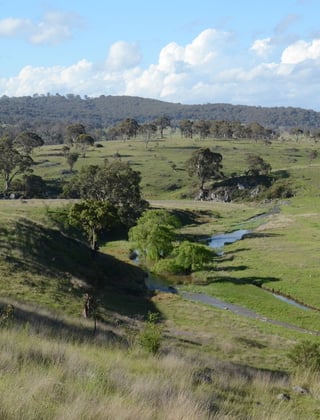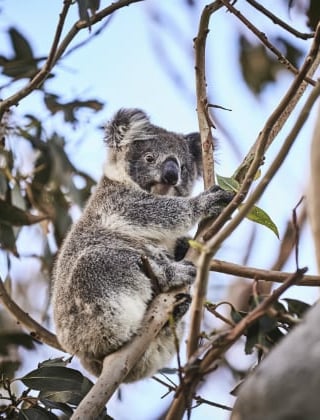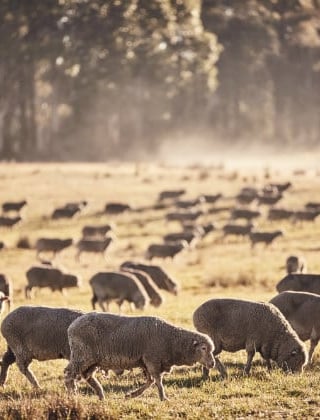Building biodiversity & natural capital

The Farming for the Future program recently issued five case studies of woolgrowers that are managing investment in their property’s natural capital (environmental assets such as soil, water and vegetation) in a way that maximises both business prosperity and environmental returns including biodiversity.
PHOTO: Tetra Images
Consumers, brands and regulatory bodies are increasingly wanting evidence that farmers are responsibly managing their farm’s natural resources. Furthermore, there are market signals that they have expectations for farmers to adopt practices that actually build their farm’s natural capital.
In response, and as part of a broad strategy to help Australian woolgrowers increase demand for their wool, AWI is co-investing in the Farming for the Future program to demonstrate to woolgrowers the business case for improving their farms’ natural capital including biodiversity.
Farming for the Future is a significant national research program initiated by the philanthropic Macdoch Foundation and is supported by other philanthropists and industry partners including the National Farmers’ Federation and MLA.
“AWI’s participation in the Farming for the Future program seeks to provide evidence and the business case for interested Australian woolgrowers to simultaneously improve their natural capital and also meet market requirements,” said AWI’s Program Manager, Fibre Advocacy & Eco Credentials, Angus Ireland.
“The program is developing supporting tools that make this evidence relevant and accessible to woolgrowers, to inform their business planning and decision making, with specific insights on biodiversity. This new set of five case studies is the program’s first set of outputs for woolgrowers.”
Jo and Greg Bear

PHOTO: Jo Bear
- 'Tiverton', Loddon Vale, north central Victoria (4,500 ha)
- Specialist woolgrower (medium micron) and lamb production (6,600 ewes)
- Download the case study here
John and Isabelle Atkinson
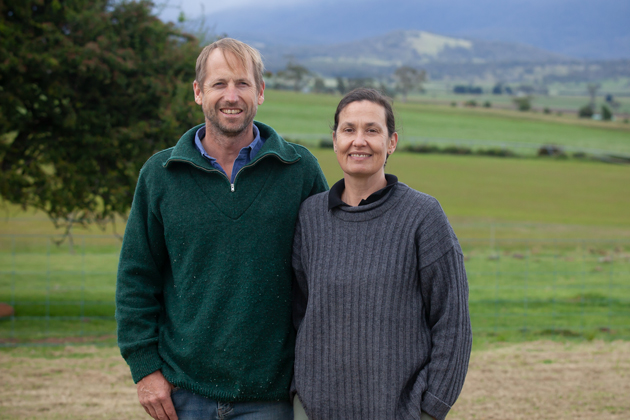
PHOTO: Alex Maisey
- ‘Maitland’, Campbell Town, Tasmania (3,840 ha)
- Mixed enterprise sheep and cropping (superfine Merino wool); 5,700 head of Merinos including 1,900 breeding ewes
- Download the case study here
Will and Nina Bennett

PHOTO: Alex Maisey
- ‘Ashby’, Ross, Tasmania (4,000 ha)
- Merino sheep and mixed cropping (superfine Merino wool); 20,000 Merinos (11,000 breeding ewes)
- Download the case study here
Angus and Lucy Maurice
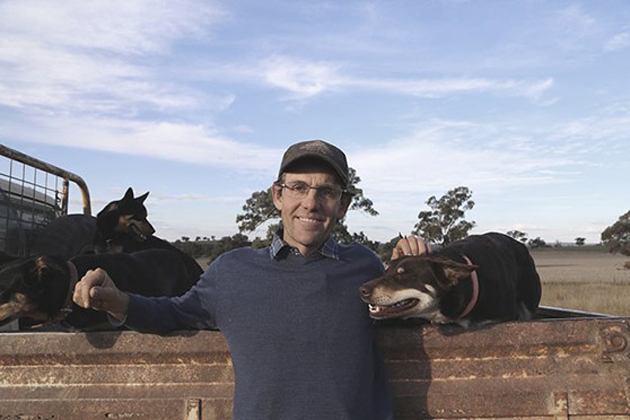
PHOTO: Angus Maurice
- ‘Gillinghall’, Wellington, central west NSW (2,520 ha)
- Mixed enterprise sheep, cropping and eggs (18-micron Merino); 2,800 Merino ewes
- Download the case study here
Stuart Hutton, ‘Fern Hill’, Guyra NSW

Stuart Hutton and his partner Susan. PHOTO: Alex Maisey
For woolgrower Stuart Hutton on the Northern Tablelands of NSW, a careful revision to a grazing strategy – with a focus on simplicity, improving biodiversity, and soil health – has stood the test of time through droughts and flooding rains.
At the top of a range on the Northern Tablelands of NSW is ‘Fern Hill’, a 1,000 ha farm owned by Stuart Hutton whose business comprises 60% Merino wool and 40% cattle. He currently runs 1,000 ewes, 950 lambs and 500-600 wethers. They are a plainer bodied sheep that require no mulesing, with 15-17 micron wool of a bold or crimping type.
The landscape of rolling hills at ‘Fern Hill’ creates a mosaic of vegetation types interspersed among lush paddocks, with stringybark woodland on basalt hills, patches of open grassy box woodland, and peppermint forest along wetter gullies.
Growing up on ‘Fern Hill’, Stuart observed first-hand profound changes to farm management – and the effects these changes had on the land.
“We used to see Scarlet Robins regularly when we were children. After that we started on the clearing regime. And then they declined,” Stuart said. Eventually, this species disappeared from the farm completely.
As a young adult, Stuart became frustrated with the stress and time commitment associated with spraying pastures and using chemicals.
“That doesn’t stop ever – more fertiliser, more spraying, more equipment. My father and I were trying to work out how to get off that cycle, and to ask - was that the right way to do things?” he said.
In 1996, looking for answers, Stuart did a course in regenerative agriculture. This inspired him to make substantial changes to his farming strategy, and he hasn’t looked back.
Keeping things simple
Today, Stuart’s focus is on maintaining healthy pastures and soil, while keeping things as simple as possible. His grazing strategy is carefully planned. Sheep and cattle are kept in a single mob, and rotated through 80 paddocks. Paddocks are rested for long periods to promote growth and paddock health. Calves and lambs are quickly returned to the mob after weaning.
Stuart uses MaiaGrazing, an electronic grazing chart planning system, to calculate the carrying capacity of his farm – the amount of stock the land can support through different seasons and climatic conditions. Stuart adjusts the stocking rate regularly to match to carrying capacity.
Stuart believes this strategy has an important advantage. “It takes a lot of stress out of the system. If it’s starting to get dry and your data is telling you to sell stock, you go and sell stock.” Instead of worrying, he trusts the strategy and uses it to guide his management.
Through droughts and flooding rains
Stuart reckons his management technique has stood the test of time. “Having done it since ’96, it’s a fair trial. We’ve been through lots of droughts, and the system really works.”
A major test was the 2019 drought in NSW. Stuart’s grazing charts predicted a substantial reduction in the carrying capacity of his land associated with the reduction in rainfall. “The numbers were telling me that I needed to act to save my land.” So he sold most of his stock.
Stuart feels strongly that he made the right choice. “Many farmers were spending $10,000 per week on feed during 2019, and the stress was incredible for them. I didn’t have that stress - I just sold everything and went on holiday. I wouldn’t do it any other way.”
Stuart also believes his management facilitates healthier soils and healthier land. While the drought caused substantial tree deaths in the broader district, he observed very few dead trees on ‘Fern Hill’. When the drought broke, the farm was hit with 350 mm of rain. While other farms had major issues with clogged dams and gullies, Stuart’s farm responded differently. There was no runoff – all the water went into the soil. “To me it was perfect, because it would move through the soil profile slowly, and there was no loss of soil.”
Return of the Scarlet Robin
While Stuart hasn’t noticed changes in production per se since he changed his strategy, he feels there are other important benefits in having healthier land. “For me, I count biodiversity and soil health as profit within my system. I’m hoping that we will get recognised for building biodiversity in the future. It’s not just value for me, its value for everybody.”
Quantifying the value of biodiversity and soil health is an important, yet unanswered question for Stuart. That’s why he’s part of Farming for the Future, a multi-year study – the biggest of its kind in the world – that aims to quantify the contribution of different types of natural resources to profitability across hundreds of Australian farms. With this insight, farmers like Stuart will be able to make more informed decisions about how to best manage their land for both its health and farm profit.
Stuart and his partner Susan enjoy the benefits that come from living on healthy land. “I really do love waking up in the morning and getting on the horses and moving stock. Whenever we can, we go out on the horses because it’s quiet and you see more birds.”
Since 1996, they’ve noticed more birds, and new species of birds gradually returning to the property. Now, the farm boasts a vibrant list of species – including Latham’s Snipe, Buff-banded Rail, and, excitingly, the Scarlet Robin.
“It’s a real pleasure to go out and see that stuff. I think we’ve still got a long way to go in that regard – but we’ve planted lots of trees and shrubs to try and keep them.”
Access the full case study here.
This article appeared in the September 2023 edition of AWI’s Beyond the Bale magazine. Reproduction of the article is encouraged.
More information:






